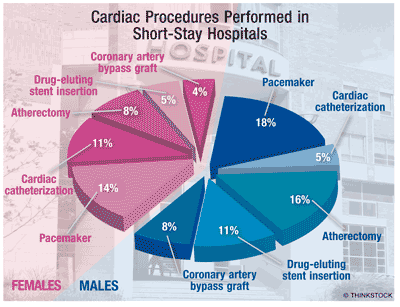US Pharm. 2014;39(2):74.
Medical devices represent a relatively small share of national health care dollars (~$200 billion). In 2010, 7.454 million (242.2 per 10,000 population) inpatient cardiovascular (CV) procedures were performed; of these, 58% took place in male patients (284.8 per 10,000 population). CV-system operations performed during short-stay hospitalization were 28.5% more common in patients aged ≥65 years than in those aged 45 to 64 years. Operations on vessels of the heart declined notably between 2000 (41.2 per 10,000 population) and 2010 (33.1 per 10,000 population), with the largest decrease (24%) observed among female patients.

Cardiac Catheterization: This was the most frequent (33.4 per 10,000 population) of all procedures performed on the CV system. It was performed predominantly in male patients (62%) and in those aged ≥65 years (123.8 per 10,000 population). Cardiac catheterization was generally followed by interventional or therapeutic procedures to open blocked arteries—e.g., atherectomy, stent placement, grafting, or pacemaker implantation.
Coronary Atherectomy: This was the second most common procedure (16.2 per 10,000 population) performed on the CV system. Two-thirds of patients undergoing the procedure were male. More than twice the number of ballooning procedures were performed in cardiac patients aged ≥65 years (63.4 per 10,000 population) than in those aged 45 to 64 years. A new coronary atherectomy system, the Diamondback-360, is the first in more than 20 years to be FDA-approved to treat severely calcified lesions. Fifteen percent of patients needing an angioplasty to treat a heart blockage have severely abnormal levels of arterial calcium that would benefit from this new device.
Coronary Artery Stent: This was the third most frequent (0.454 million) procedure performed on the CV system. Stent recipients were predominantly male (68%). The number of recipients aged 45 to 64 years was one-tenth that of patients aged ≥65 years (75.3 per 10,000 population). Drug-eluting stents were used in 73% of all coronary artery stent insertions.
Coronary Artery Bypass Graft: This was by far the most frequently performed procedure in male patients (75%). With progression of age to ≥85 years, the number of grafting procedures in patients aged 65 to 84 years rose from 77% to 84% by 2010.
Pacemaker: Therapy was broadened to include prophylactic pacing for pre–heart block syndrome. The dual-chamber pacemaker was the type most frequently used, followed by single-ventricular, single-atrial, and biventricular devices. Although nearly equal numbers of insertion, removal, and revision of pacemaker leads or devices were performed in male and female patients, it was the least common (12 per 10,000 population) procedure performed on the CV system.
To comment on this article, contact rdavidson@uspharmacist.com.





